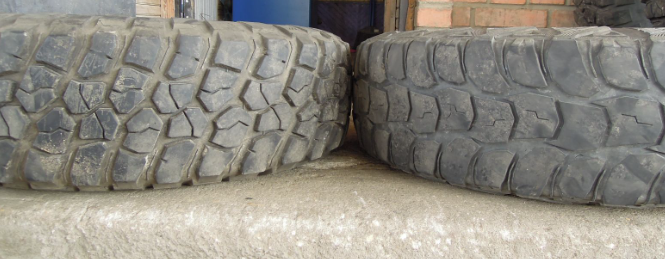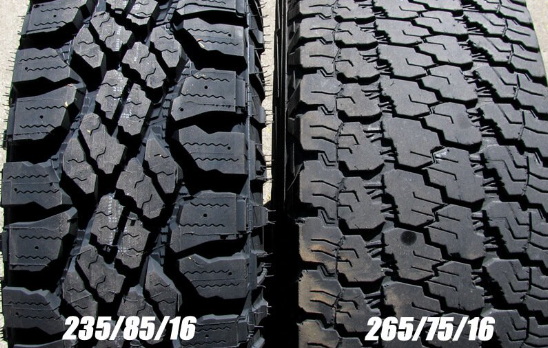Tire sizes are not random numbers but index various essential factors. These include the width of the tire in millimeters, its aspect ratio, and the wheel diameter and speed rating. Understanding these four components is critical to choosing the right size for your vehicle.
This article provides an easy-to-understand breakdown of how to interpret tire size indexes, allowing you to determine whether two tires, such as 235 85R16 Vs. 265 75R16, are interchangeable or not. With this knowledge, you can confidently choose a suitable set of tires for your vehicle that meets all safety standards without any difficulty.
235/85R16 Vs 265/75R16: Find The Difference Considering 4 Aspects

When deciding which tire size to use, the tires must be similar or very close in Sidewall Height. It is possible to interchange between two sizes without changing all the tires. The Tire Size Index provides four pieces of information, including Width, Aspect Ratio, Construction Type, and Rim Diameter – giving an easy way to identify a tire’s size at a glance.
The tire size index 235 85R16 is fragmented, providing four pieces of information.
- 235 stands for – Tire Width in Millimeters
- 85 stands for – The Aspect Ratio of Height/Width
- R stands for – Construction Type
- 16 stands for – Rim Diameter in Inches
Comparing the 235 85R16 and 265 75R16 tire sizes can provide valuable insight into their interchangeability. To make an educated decision, four key points should be considered when comparing the two tires.
Width
When consulting the tire size index, it is essential to note that the first three digits indicate the Width of a tire. This width is expressed in millimeters and can be converted to inches for easier comparison.
For example, they are comparing two tires with sizes 235 85R16 and 265 75R16, yielding a difference in width of 10.43 – 9.25 = 1.18 inches, indicating that the latter has a broader sidewall than the former by more than one inch. To determine if these two tires are interchangeable, it is necessary to compare their Aspect Ratio or Sidewall Height before making any decisions regarding their use.
Aspect Ratio
Understanding a tire’s Aspect Ratio is essential to determine its Sidewall Height. The two numbers following the Width signify its Aspect Ratio, measured in percentage. For example, the Aspect Ratio for 235 85R16 and 265 75R16 are respectively 85% and 75%.
To calculate the Sidewall Height of these two tires, you need to multiply their respective Width by their corresponding Aspect Ratios. The result will be 199.75 millimeters (7.86 inches) for 235 85R16; 198.75 millimeters (7.82 inches) for 265 75R16, showing that they are almost identical in height with only a one-millimeter difference between them. This means that these two sizes can be used interchangeably – if a broader scope is preferred, then 265 75R16 should be chosen, while a thinner size would require going with 235 85R16 instead.
Construction Type
The tire size index defines tire construction types. A letter is used to designate the type of construction for a given tire, with ‘R’ denoting radial tires and ‘B’ denoting cross-ply or bias-ply tires. Radial tires have a sophisticated structure with square footprints on top and are ideal for driving on roads, providing excellent gas efficiency and water and damage resistance. Cross-ply or bias-ply tires, meanwhile, are better suited to off-road conditions.
Both types of tires provide different benefits depending on the driving environment; selecting the correct type of tire is essential to get optimal performance from your vehicle. Understanding how these two types differ in design and purpose allows you to decide which best suits your needs.
Rim Diameter
Rim Diameter is an essential factor when considering the purchase of a tire. This measurement is expressed in inches and can be determined by examining the last two digits of a given tire size index. For example, 235 85R16 vs. 265 75R16 tires have a Rim Diameter of 16 inches.
It is essential to pay attention to this detail as it will indicate whether or not the tire being considered is suitable for use with one’s vehicle wheel-rim type. As such, when looking for tires that correspond with a 16-inch wheel rim type, one must look specifically for those sizes that list 16 inches as their Rim Diameter.
Wrapping Up With A Comparison Table Between 235/85R16 And 265/75R16:
| Aspects | 265 75R16 | 235 85R16 | Difference |
| Diameter inches | 31.65 | 31.73 | 0.08 (0.2%) |
| Width inches | 10.43 | 9.25 | -1.18 (-11.3%) |
| Circumference inches | 99.43 | 99.68 | 0.25 (0.2%) |
| Sidewall Height inches | 7.82 | 7.86 | 0.04 (0.5%) |
| Revs per mile | 637.23 | 635.65 | -1.58 (-0.2%) |
| Aspect Ratio % | 75 | 85 | 10 |
The 235 85R16 size tire is thinner than its counterpart when examined about Sidewall Height, with a negligible gap between them. Consequently, these tires are interchangeable; should a thinner one be desired, the 235 85R16 size would be recommended, and vice versa.
Final Words
Interpreting the tire size index is now a much simpler process. By comparing tires, one can quickly determine the width, aspect ratio, construction type, and rim diameter of any given tire. With this knowledge, individuals are equipped with the understanding necessary to make an informed decision when selecting the correct size tire for their vehicle.
